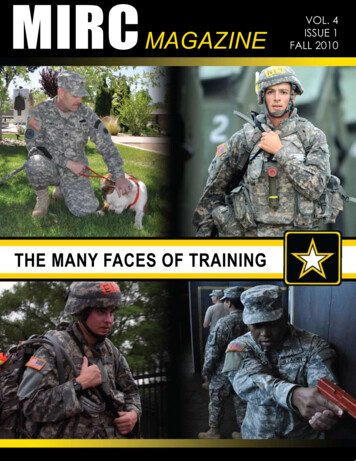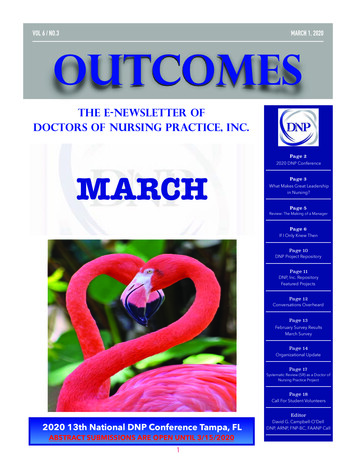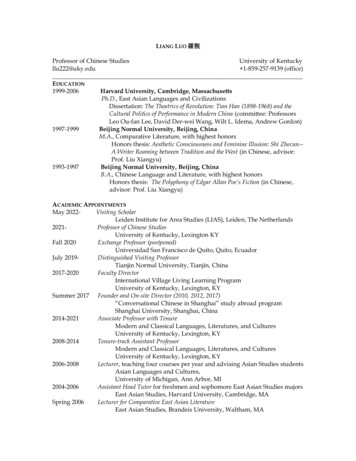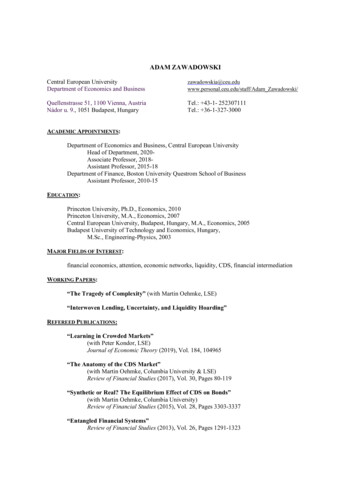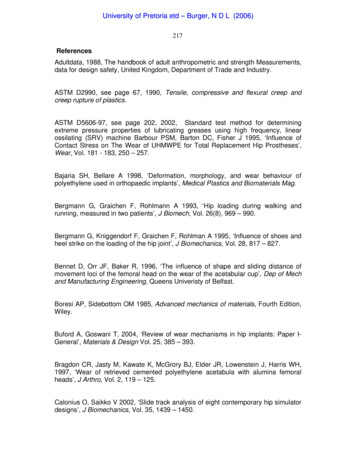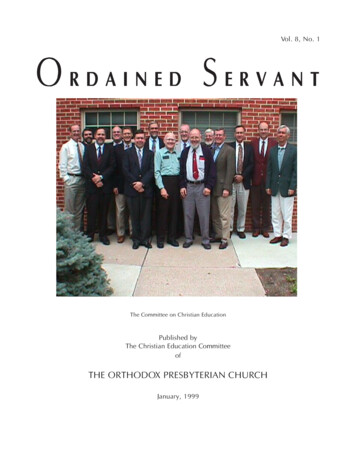
Transcription
Vol. 8, No. 1ORDAINED SERVANTThe Committee on Christian EducationPublished byThe Christian Education CommitteeofTHE ORTHODOX PRESBYTERIAN CHURCHJanuary, 1999
ORDAINED SERVANTStatement Of PurposeOrdained Servant exists to provide solid materials for the equipping of office-bearers to serve more faithfully. The goal of this journalis to assist the ordained servants of the church to become more fruitful in their particular ministry so that they in turn will be more capableto prepare God's people for works of service. To attain this goal Ordained Servant will include articles (both old and new) of a theoreticaland practical nature with the emphasis tending toward practical articles wrestling with perennial and thorny problems encountered byoffice-bearers.Editorial Policy1. Ordained Servant publishes articles inculcating biblical presbyterianism in accord with the constitution of the Orthodox PresbyterianChurch and helpful articles from collateral Reformed traditions; however, views expressed by the writers do not necessarily representthe position of Ordained Servant or of the Church.2. Ordained Servant occasionally publishes articles on issues on which differing positions are taken by officers in good standing in theOrthodox Presbyterian Church. Ordained Servant does not intend to take a partisan stand, but welcomes articles from various viewpointsin harmony with the constitution of the Orthodox Presbyterian Church.Published for the Christian Education Committee of the Orthodox Presbyterian Churchunder direction ofDr. James Gidley, Mr. David Winslow, Rev. Larry Wilson and Rev. William ShishkoContents: Vol. 8, No. 1Editorial Notes.1Women in Office; Especially about Deaconesses, by Dr. Soon-Gil Hur.2The Forgotten John Murray, by D. G. Hart and John R. Muether.8Evolution: The Materialistic Juggernaut - A Christian Challenge (Pt. 2) by Gregory E. Reynolds.11Pastor to Pastor: The Riches of Spurgeon (Pt. 3) , by William Shishko.16Elder to Elder, ‘Home Visitation and Family Devotions’, by David Winslow.19About Children in the Worship Services of the Church, by David King.21Ordained Servant (USSN pending) is published quarterly by Pleroma Press, PO Box 242,5645 73rd St SW, Carson, ND 58529-0242. Copies to ordained officers of the OrthodoxPresbyterian Church are paid for by the Committee on Christian Education. Others remit 12per year. Periodicals postage pending at Carson, ND. POSTMASTER send addresscorrection changes to Ordained Servant, PO Box 242, Carson, ND 58529-0242.Please send all materials intended for possible publication in Ordained Servant to the Editor, G. I.Williamson, 406 Normal College Ave., Sheldon, IA 51201. (Or send it in a text file, by Email to:williamson.1@opc.org). Please send all requests for additional copies, or back issues, to the Publisher,Stephen Sturlaugson, PLEROMA PRESS, Box 242, Carson N.D. 58529. Telephone: 701-622-3862 (Email:StephenS@westriv.com), or download them from The Orthodox Presbyterian Church's Web site on theInternet at: http://www.opc.org.“Ordained Servant — Vol. 8, No. 1
Editorial NotesThis issue marks the beginning of the 8thyear of publication of Ordained Servant Itis our sincere hope that it has served thechurch well, and not only the Orthodox Presbyterian Church but also others from around theworld who have accessed our internet web site (athttp://www.opc.org). But Ordained Servant is onlya small part of what is now available. Throughthe diligent work of the Rev. Stephen Pribblethere is now available, at that site, some of thehistoric General Assembly papers which havemarked the life of the OPC, as well as the doctrinal standards of the Church (with proof texts),and a selection of other resource materials. It isalso now possible to send e-mail to most of thepastors of the OPC (those who use computers) byuse of an address that is easy to remember. Mine,for example, is simply: williamson.1@opc.org (and,for most of our pastors, you would only need tosubstitute their last name for mine to have itright. You would need to change the number, ofcourse, when it comes to a name like Miller orSmith because there are so many—but you getthe idea). It is our hope that through the OPC website Ordained Servant will do its part in reachingto the ends of the earth in promoting the cause ofChrist.In this issue we present the second part of Dr.Soon-Gil Hur's paper on the subject of womendeacons. We do this despite the fact that we(the editor, as well as overseers of the editor) arenot convinced by Dr. Hur's paper. We do it,rather, because we believe it is very important forthe members of the Orthodox Presbyterian Church(OPC)—and especially pastors, ruling elders anddeacons of the OPC—to be well informed of theviews and practices of other churches that belongto the International Conference of ReformedChurches (ICRC) in which we now hold membership. It was at the 1997 ICRC convened in Seoul,Korea, that this paper was presented. Four representatives were there on behalf of the OPC, andthey were thus able to hear it. But it is our hopethat by publishing this paper—even though we donot agree with its conclusions—many other officebearers of our church will be stimulated to thinkfurther on this subject as a result of Dr. Hur'spaper.One of the good things that we've learnedfrom the use of e-mail is the advantage ofbrevity. Have we not all learned that wecan usually say all that we need to say much moresuccinctly than we used to say it before thismodern wonder came along? In deference to thispresent-day preference for getting to the point myoverseers have urged me to try to keep the lengthof the articles in Ordained Servant as short aspossible. So if you have something that you wantto say through the pages of Ordained Servantplease try to keep it down to four pages, or less(single spaced 12 point type).The cover of this issue features a recentpicture of the Committee on ChristianEducation. The men shown are—from leftto right—David Winslow, John Muether, DougFelch, Doug Clawson, Larry Wilson, Alan Strange,Tom Tyson, G.I. Williamson, John Galbraith,Kingsley Elder, Paul MacDonald, Allen Curry,William Shishko, James Gidley and GeorgeMiladin (Larry Woiwode is also a member of theCommittee but was unable to attend the Octobermeeting and therefore missed out on the picture).From time to time we still get requests forback issues of Ordained Servant and mostof those originally printed are now longsince gone. We would therefore again draw attention to the fact that all of the back issues ofOrdained Servant are readily available for electronic download at our http://www.opc.org website.Ordained Servant— Vol. 8, No. 11
Women in Office;Especially About “Deaconesses”Dr. Soon-Gil HurPart 2 of an Address presented at the 1977 ICRC in Korea3. DEACONESSWe come now to the main question. If deaconsare not involved in authoritative teaching and authoritative disciplinary action, but only in serving,is it possible to have female deacons in congregational life? Is there any evidence in the Scriptures orany trace in history? The Scriptures show us somepositive evidence that women were involved indiaconal work in the congregation. 1 Timothy 3:11,Romans 16:1, 1 Timothy 5:3-16, and Acts 6:1-6 arethe main places of evidence given in the Bible.3.1 “Women” (γυναικες) in 1 Timothy 3:11The group of women mentioned in 1 Timothy3:11 has become the centre of much controversy.Many of today’s exegetes come to the conclusionthat they were female servants (deaconesses). Itssignificance is derived from the fact that "the women"appear in the midst of describing the qualificationsnecessary for the office of deacon. Who are thesewomen?The Greek word can mean wives. Its definitionis therefore dependent upon a consideration of thecontext. Exegetes bring forth various translationsand opinions: wives of overseers and deacons, wivesof deacons, female deacons, and a group similar tobut distinct from deacons (male).Instead of using “their,” Paul refers to the women ina manner which makes them parallel to the bishopsand deacons, implying a new but similar class of8persons. He says, “The women likewise.” Thesignificance of these words becomes very clear whenit is set alongside the introduction of the bishops (vs.2) and of the deacons (vs. 8). Paul said, “A bishopmust be . . .” “Deacons likewise (must be),” “Thewoman likewise (must be).” The correlation between the three seems to be very clear.It ought also to be noted that both the sentenceintroducing the deacons and the one introducing thewomen do not have verbs of their own, but presumethe verb already used to describe the elders: δει,9‘must be.’ The requirements for the deacons and thewomen run parallel.Thus the context, and the parallelism betweenthe three groups (overseers, deacons, and women),and the parallelism between the prerequisites forthe women and the deacons would have us conclude that the women of 1 Timothy 3:11 cannot bewives of the deacons. They must be a group ofwomen who are similar to the deacons, or veryclosely related to the work of the deacons. It consequently may be said that they were deaconesses,even though it cannot be stated with absolute certainty. We may at least conclude that they were10assistant-deacons.They cannot be wives of both bishops and dea6cons. It is more likely that they were the wives ofdeacons. However, in this case the question arises: ifPaul intended to talk about the wives of deacons,?why did he not add the possessive pronoun “their?”86Calvin says this about this text, “He speaks of the wivesof both elders and deacons, because they have to assisttheir husbands in their office.” Commentary on 1 Timothy9710Nicholas, D.R., What's a Woman to do in the Churches?,Good Life Productions Inc. 1979, p. 40.2Schreiner, T.R., “The Valuable Ministries of Women inthe Context of Male Leadership, A Survey of Old andNew Testament Examples and Teaching” in John Piperand Wayne Grudem (eds.), Recovering Biblical Manhood &Womanhood, Crossway Books, 1991, pp. 213,214. VanBruggen, pp. 112,113.See the study of James B. Hurley, Man and Woman inBiblical Perspective, Zondervan, 1981, especially pp. 223233.Hendriksen, W., 1 & 2 Timothy and Titus, The Banner ofTruth Trust, 1972 reprinted, p. 133.Ordained Servant — Vol. 8, No. 1
ESPECIALLY ABOUT “DEACONESSES”3.2 Phoebe, ‘A servant of the church’ in Rom. 16:1Is there any other place in the Scriptures that theidea of deaconess can be supported with? We oughtnot to base our understanding of the deaconess onjust one text alone. Scripture must always be read inthe light of parts of other Scripture. “When there isa question about the true and full sense of anyScripture (which is not manifold, but one) it must besearched and known by other places that speak11more clearly.” “There is a unity of the Scriptures.”There are some other places in the Scriptureswhich point in the direction of the institution ofdeaconess. One of them is Romans 16:1 in whichPhoebe is called “a servant (διακονος) of the Churchat Chencrea.” Regarding the word διακονος thereare dividing opinions between exegetes. Bible translations therefore, differ from each other (AV: a servant; RSV: a deaconess; NIV: a servant (deaconess infootnote), Korean Bible: a servant). ιακονος cansimply mean “servant,” or “the one who serves,”“minister,” or even “deacon” as an office. The meaning must be determined according to the context.If διακονος was never used as a title of office in theScriptures, διακονος here must be understood simplyas a servant or minister. But it was used as a title ofoffice (1 Timothy 3:8; Philippians 1:1). Had Phoebebeen a male, we would have immediately assumedthis reference to be a reference to the office of deacon.The fact that Phoebe is female has resulted in differingopinions. However, this word points into the direction of office, because the women in 1 Timothy 3:11may be assumed to be deaconesses. She, whom manybelieve to have been the bearer of Paul’s letter, wasintroduced to the Church of Rome in terms of herrelationship to her Church, and further commendedon the basis of her past service to God’s people. Shemust have had a particular function in the church. Theword διακονος cannot as yet be a technical term todenote the office of deacon. It could be understoodsimply in terms of a regular pattern of service undertaken by her on behalf of her local church. It would bepremature to speak of an established office ofdiaconate. One, hereby, can propose that only later ondid the term διακονος function as indicator of an12office, namely in 1 Timothy 3. It seems certain,11Westminster Confession, 1:9however, that the word διακονος was already crystallizing as a title for an office. A question, then, maybe put: if it was already being used as an official title,why did Paul use the masculine διακονος, and not“deaconess?” In that time the feminine “deaconess”did not exist. So in the case of Phoebe, διακονος, themasculine form of ‘deacon,’ was used for both men13and women. Phoebe was in Rome in some sort ofofficial capacity, as διακονος of the Church inChencrea. It is clear that she was a female servant.It is as yet impossible to say with absolute certainty that the office of deaconess was introduced inthe early Church. But it can be said with certaintythat 1 Timothy 3:11 and Romans 16:1 clearly point ina positive direction. Further the fact that the womenwho were endowed with spiritual gifts were employed for the upbuilding of the Church by the Lordalso makes us think in this direction. It is veryinteresting that Paul had a number of female fellowworkers. He, for example, refers to Priscilla, Euodia,and Syntyche (Romans 16:3; Philippians 4:2). Hisministry involved a significant number of women asfellow-workers.What was then the role of the women in hisministry? It cannot be said in a single word. Onemust look for detailed information in the Scriptures.There is evidence that Priscilla, with her husband,taught Apollos in her house (Acts 18:24-28). But onecannot conclude from this that she was acting as anelder or teacher in a formal sense, because onecannot find any female ruling elder or female teaching elder in the New Testament, as this sort of office,which includes the exercising of authority over men,was prohibited for women (1 Timothy 2:11-14; 1Corinthians 14:33-35). One can, however, safely conclude from the women among Paul’s fellow-workers that they were involved in the missionary enterprise and for the upbuilding of the Church withendowed gifts. Thus one can safely say that Phoebewas a very active servant (deaconess) and helperwho faithfully served for the edification of Chencreanchurch life.3.3 “Widows” in 1 Timothy 5:9 and in Acts 6:1The possibility that deaconesses existed in theapostolic church is strengthened by the interpretation of the widows mentioned in 1 Timothy 5:9 and12Dunn, J.D.G. Romans 9-16 (Word Biblical Commentary,Vol. 38b), Word Books, 1988, p. 887.13Hurley, p. 231Ordained Servant — Vol. 8, No. 13
WOMEN IN OFFICEin Acts 6:1. Widows in both these places appear toindicate a deaconess.3.3.1 “Widows” in 1 Timothy 5:9With respect to the “widows” of 1 Timothy 5:9there are also dividing views. Some exegetes see14them as the widows in need. But Calvin figuresthey were deaconesses. He introduced two sorts ofdeacons according to his interpretation of Romans12:8 and 1 Timothy 5:9-10. He, in the first place,refers to the deacons who distribute the alms according to Romans 12:8: “He that gives, let him do it withsimplicity; . . . he that shows mercy, with cheerfulness.” And the second kind of deacon refers to thosewho devoted themselves to the care of the poor andsick. He says,“Of this sort were the widows whom Paul mentions to Timothy (I Timothy 5:9-10). Women couldfill no other public office than to devote themselvesto the care of the poor. If we accept this (as it mustbe accepted), there would be two kinds of deacons:one to serve the church in administering the affairsof the poor; the other, in caring for the poor themselves.”It is noteworthy that Calvin understood thewidows who were deaconesses in the church to havehad a “public office.”It seems to be very clear from the context that the15widows were some sort of female servant. Paulcommands, “Honour widows who are real widows” (vs. 3). If one reads this in the context of thewhole chapter, he will quickly see that “honour”does not refer to financial care for the widows. Verse18 makes reference to financial care for widows, butdoes not use the word “honour.” Paul further commands, “Let the elders who rule well be consideredworthy of double honour” (vs. 17). Verse 18 thengoes on to speak about the financial care for theelders, but it does not speak of “honour.” In theverses 9-15 Paul speaks about widows who are more14J. Hurley says that the early churches cared for thewidows in Jerusalem and Joppa. According to him theGreek-speaking widows in Jerusalem (Acts 6:1) and thegrieving widows at the death of Dorcas were the widowsin need (Acts 9:39) (p. 121).15For an in depth study see Van Bruggen, pp. 119-140(“Weduwen in ere”).4than sixty years of age and who can be enrolled insomething. This would certainly not be for financialsupport, because it would be very strange if onlywidows over the age of 60 and of good testimonywould receive financial support. Therefore it is clearthat in these verses Paul does not command honourfor widows by means of financial support. “Honour”means much more than financial support. Real widows are worthy of honour, thus they can be enrolled.Real widows are not simply determined by the agesixty. They are distinguished from the widows whohave children and are supported by their brothersand sisters (vss. 3-5 16). These real widows are notconnected to financial matters, but to a special task,as the word “enroll” indicates. The Greek word“καλεγεσθαι” means “recruit,” “appoint,” and theverb points to the people who are called and set apartfor a special task. Thus in verse 9 we can think of it asthe appointment of a widow to a special task. Whatthis task consisted of is not clearly indicated. It maynot have been necessary for Paul to mention it,because the congregation in Ephesus already knewthe institution of serving widows. However, verse13 gives us some hints, namely, that the task included going around from house to house for theupbuilding of the church.In concluding this consideration of the widowsin 1 Timothy 5 we may ask whether these widowsare the same as the women mentioned in 1 Timothy3:11 or perhaps similar to them. They could belong tothe same group, because 3:11 makes no reference tothe marital status of the women. Both the womenand the widows were clearly appointed to a permanent task. Why then two references in the sameletter? someone may ask. It is not strange that theapostle wrote about the same group twice, becausein 3:11 he deals with the qualification, while inchapter 5 he discusses them in connection with mutual relationships in the church. He deals with overseers in chapter 3, but he also deals with them(elders) in chapter 5. Consequently it is possible thatthe elderly widows were appointed as women fordiaconal help. Whatever the case, one thing is veryclear: that some widows (women) were appointedfor the task of upbuilding congregational life.3.3.2 “Widows” in Acts 6:1The ministry of widows for the upbuilding ofcongregational life seems to have been a commonthing in the congregation of Jerusalem. Many ex-Ordained Servant — Vol. 8, No. 1
ESPECIALLY ABOUT “DEACONESSES”egetes see the Greek widows as those who wereneglected in the receiving of financial care. But thereare also other exegetes who understand them as notbeing allowed to share in the distributing of care.From what we have so far seen about widows, thelatter seems to be a more correct interpretation. Thewhole point depends on how one understands “thedaily ministration” in Acts 6:1. There are differenttranslations: NIV and RSV: “the daily distribution;”Korean Bible: “the daily relief.” Does it mean thedaily caring for the poor?It can be assumed that widows in general werepoor and needed financial care in that time. But itwas not always true. Dorcas in Joppa was a discipleof the Lord called Tabitha (Dorcas; Acts 9:36-45). Shewas always doing good and helping the poor. Shehad made many robes and clothing for the poor.When she died, many widows came to her place andwept, showing Paul the robes and clothing thatDorcas had made “while she was still with them.”When one closely looks into this story, one cannotsay that she had made clothing for these widows.There is no sign at all of it. Dorcas might also be oneamong the widows. They could have been doinggood works together by making clothing and robesfor the poor and for the disciples of the Lord. Ofcourse, this does not mean that all widows were rich.One can only say that widows were not always poorand surviving on alms.When we read Acts 6:1 in the context of theprevious chapters, it would be very strange tothink that a group of Greek widows were neglected from the distribution of goods. Acts 2:45and 4:35 inform us that everyone had accordingas he had need. It is surprising to hear that agroup of widows all of a sudden were neglectedand left in poverty. If this were true, there wasracial discrimination in the first congregation!However, there is no trace of this at all, for thecongregation was united in the Lord. Therefore itis unreasonable to say that the murmuring of theGreeks broke out because their widows were neglected in the distribution of financial assistance.The Greeks murmured for another reason.There is a possibility that “the daily ministration” does not mean “daily care for the needy” butsomething different. Pay careful attention to whatthe twelve said to the multitude of disciples wheninstructing them to look out for seven men. Theapostles wanted them “to serve at tables,” so thatthey might devote themselves to prayer and tothe ministry of the Word (vs. 2). Thus we noticethat the point of the whole matter was “tableservice.” From the “table” in verse 2 “the daily16ministration” (vs. 1) gets a new meaning. If oneaccepts this new meaning, it is clear that thereason for the Greek murmuring was not becausetheir widows were neglected in the material distribution but because their widows were beingneglected when it came to serving at these tables,dispensing mercy. It was well known that the firstcongregation had the daily table service. Acts 2:46says, “And day by day, attending the temple together and breaking bread in their homes, theypartook of food with glad and generous hearts . . .”(see also 5:42; “every day”). The daily table was thetable of the communion meal, and at the sametime a meal for the needy. In that time the congregation in Jerusalem grew fast and the twelveapostles could not sufficiently manage the distribution of alms and the daily table service alone.“Every day in the temple and at home” they hadmeetings and communion meals. Believers hadmeetings not merely in one home, but in manyhomes and at many places. Obviously they had tohave some helpers. At the daily meeting and thetable service some Hebrew widows could havebeen involved in the proper administration of thecommunion meal as helpers. For this ministry theGreek widows were thoughtlessly bypassed, andneglected. It is difficult to say what sort of capacity the widows had in that time. One thing however, is sure, they performed a positive ministration at the daily meeting and table. One may seehere in Acts 6 a glimmering of the widows (deaconesses?) of 1 Timothy 5. Here one can safely saythat women were endowed with spiritual giftsand the widows were employed for the welfareand upbuilding of the Church of the Lord, eventhough it is difficult to say in what capacity thewidows served at the daily table. It, however, iscertain that they were helpers of the daily table,and were a sort of deaconess.4. HISTORICAL EVIDENCEThus far we have seen that women were activelyinvolved in the congregational life of the apostolic16See Van Bruggen, p. 67. Read also pp. 65-72 “De taakvan ‘De Zeven’” (Handelingen 6:1-7).Ordained Servant — Vol. 8, No. 15
WOMEN IN OFFICEChurch. There is some evidence that deaconesses ofsome form existed.This apostolic practice was continued in theearly Christian Church. Traces can be found in earlyChristian history. Pliny, a Roman mayor, who wassent by Trajan to Bythynia mentions in his letter twofemale slaves who were called “deaconesses”17(ministrae). It was evident that these two womenhad an office in the church, because they were calleddeaconesses. Until the 5th century traces of femaledeacons can be found. In a letter of the well-knownpreacher Chrysostomos (5th century) we come acrossa rich and faithful woman, Olympias, who was a18female deacon.In the time of the Reformation Calvin introduced female deacons in the Church of Geneva. Asmentioned already, Calvin understood the real widows of 1 Timothy 5 to be deaconesses, and he installed the office of the care of the poor. ReformedChurches in Europe followed his example and haddeaconesses until the office gradually disappearedafter the 17th century. The convent of Wezel (1568),which was an assembly of the Reformed churches incaptivity, decided that female deacons could beintroduced. In 1578, after the return from captivity,a congregation in Amsterdam actually had femaledeacons.5. CONCLUSIONFrom this study it can be concluded that womenwere involved in the ministry of the church, notexcluded from it. They were members of the body ofChrist (Galatians 3:26-28; 1 Corinthians 12:27) andwere endowed with spiritual gifts to serve the bodyof Christ (1 Corinthians 12:4, 27).However, there is a distinction between the roleof men and that of women both in married life andin church life. Women are not allowed to exerciseauthority over men. This is a clear command of theScriptures (1 Timothy 2:11-14; 1 Corinthians 14:3336). According to this instruction they are not permitted the office of elder which exercises authorityover men by discipline and by preaching the gospelin public.1718Finally, the issue is whether there is a commandto have female deacons or whether it is permitted tohave female deacons in the church today. The institution of eldership (bishop) is a matter of the command of the Lord (Acts 14:23; Titus 1:5), and it mustexist in the church. However, the office of deacon isdifferent from the office of elder. In the Scripturesthere is no command to ordain deacons, we aremerely told of their existence and their requirements. However, the installation of the office ofdeacon seems to be a right, even obligatory, becauseScripture deals with elders and deacons in a paralleling fashion (1 Timothy 3:2-13; Philippians 1:1) andthey were offices in the apostolic church.The case of deaconesses is different from thesetwo offices. If one accepts the existence of femaledeacons in the early church, it can in principle beconsidered along with male deacons. But the institution is not a matter of command, not even when itcomes to male deacons. When we do acknowledgethe office of deaconess, it is difficult to indicate whatits precise relationship is to the office of the maledeacon. There is a possibility that deaconesses wereassistants of deacons, because, even in the field ofministration, leadership is necessary. Taking suchthings into consideration one needs to be very cautious in approaching the matter of female deaconry.Plinius Minor, Epistulae X, 96.8 (A.D. 112 or 113).Edition in Sources Chretinnes 13bis (A.M. Malingrey,1968).6However, the ministry of Christian mercy andassistance for the well-being of the congregation canbe performed by them. As this paper has noted,traces of female services to the congregation can befound. In regards to the capacity of the female ministry nothing can be said with absolute certainty.Nevertheless, it can be assumed with confidencethat in the apostolic church there were deaconesses(the women in 1 Timothy 3:11 and Romans 16:1), andfemale assistants (the widows in 1 Timothy 5 andActs 6). It is not clear whether the real widows in 1Timothy 5 were deaconesses. They seem to havebeen in a different category from the other women(deaconesses), because relatively strict rules wereapplied to them—they should be no less than sixtyyears of age and could not remarry, thus their position was permanent. This differentiation howeverdoes not affect at all the fact that women wereemployed for the upbuilding of congregational lifein the church.The installation of female deacons may not be amatter of obligation for the church, because its exist-Ordained Servant — Vol. 8, No. 1
ESPECIALLY ABOUT “DEACONESSES”ence cannot be proved with absolute certainty in theScriptures. However, one cannot disregard it because there is very positive evidence for its existence,and many sisters were employed for the well-beingof the Church of the Lord. Therefore, when a Churchintroduces female deaconry, one can not say that it isunscriptural. But there must be a clear distinctionbetween eldership and deaconry, and between maleand female deacons. In the Scriptures there is evidence for the ordination of elders (1 Timothy 4:14;Acts. 14:23), but there is no clear evidence for the19ordination of deacons.In regards to female deacons it is even moreunclear than male deacons. Therefore, it is advisablethat a distinction be made between male and femaledeacons. The Korean Churches have had deaconesses for a long time. But there is a clear distinctionbetween male deac
Ordained Servant occasionally publishes articles on issues on which differing positions are taken by officers in good stand ing in the Orthodox Presbyterian Church. . Stephen Sturlaugson, PLEROMA PRESS, Box 242, Carson N.D. 58529. . StephenS@westriv.com), or download them from The Orthodox Presbyterian Church's Web site on the Internet at .






